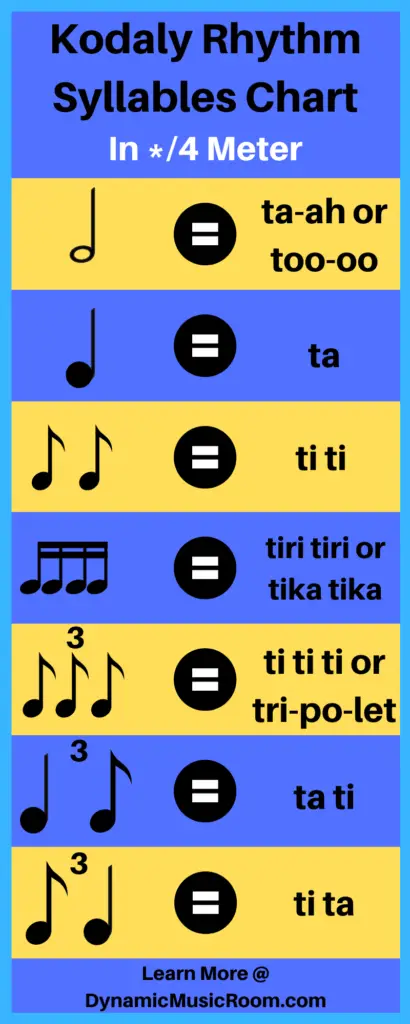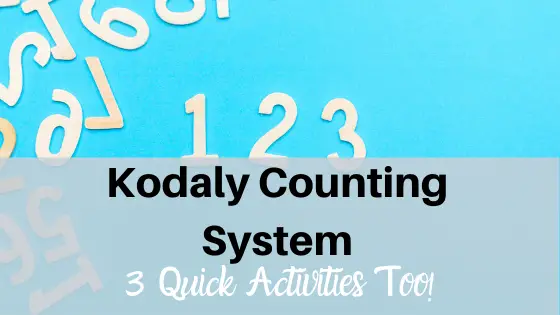Have you ever wondered about what Kodaly-inspired teachers use for rhythm?
Do you want to learn a little more about the Kodaly counting system?
The Kodaly counting system replaces rhythm values for specific syllables, such as “ta” for quarter note and “ti ti” for paired eighth notes. The syllables make it easier for students and musicians to read, perform, and hear inside.
Read on for more details about the system, variations, and 3 quick ways to use this in your classroom.
Table of Contents
The Breakdown
In this section, we’ll look at the Kodaly counting system as it is used traditionally. This is system is also known as Ta ti ti rhythm syllables.
I’ll also include some quick pros and cons of this method to address some common concerns people have with the traditional system. Look for the next section on modern variations of the traditional system.
Read more about Kodaly training.
As with all rhythm syllables, this system replaces notes with syllables making rhythms easier to read, perform, and hear inside their heads (sometimes called audiation).
This system is a replacement system. The syllables replace specific note values and traditionally doesn’t change as the meter changes.
The following rhythm values are commonly used as follows:
- Quarter note = ta
- Paired eighth notes = ti ti
- All rests = (no sound)
- Half notes = ta-ah or too
- Whole note = ta-a-a-ah or too-oo
- Sixteenth notes = tiri tiri or tika tika
- Eighth-quarter-eighth = syn-co-pa
- Dotted quarter-eighth = tam-ti
- Dotted eighth-sixteenth = tim-ka

Pros And Cons
The Kodaly counting system has some clear pros and cons, as any system does. On a personal note, I believe any system will work if used intentionally and consistently.
Pros For The Kodaly Counting System:
- Syllables help learn rhythms fast
- Activates language connections in the brain
- Very common among elementary music teachers
- Assists with audiation
Cons For The Kodaly Counting System:
- Doesn’t change as the beat changes in meter
- Syllables may make upper elementary students laugh
Variations/Alternate Options On The Kodaly Counting System
In order to address some concerns, Kodaly-inspired teachers have adapted the counting system in various ways. Here are a few of the common variations.
Beat Function
Ta-di Variation
In this variation, teachers use syllables following the rhythm value that gets the beat. Ta is the sound you say whenever a rhythm lands on the beat regardless of its value.
Di is the sound you sound when the rhythm lands halfway between one beat and the next.
This system is inspired by the takadimi syllables.
Ta-ti Variation
This is similar to the Ta-di variation except it uses ta-ti instead of ta-di to show the division of a beat. The system may be more popular with strict Kodaly-inspired teachers because it uses the “ti” syllable as the original, traditional system does.
Takadimi
This is the most popular beat function system used in secondary and collegiate level groups, but it can also be used in elementary easily.
Here is a brief description of the syllables if they were in 4/4 meter:
- Quarter note = ta
- 2 eight notes = tadi
- 4 sixteenth notes = takadimi
- 1 eighth note-2 sixteenth notes = tadimi
- 2 sixteenth notes-1 eighth note = takadi
- 3 triplets = takida
- 6 sixteenth note triplets = tavakididama
Note: All rhythms are assuming they start on the beat.
Gordon/Froseth
Gordon/Froseth syllables are popular with Music Learning Theory and Conversational Solfege. Froseth intended them to be a beat function system with syllables that help band students articulate better on top of understanding rhythm better.
Here’s a quick breakdown as if the piece were in 4/4 meter:
- Quarter note = du
- 2 eight notes = dude
- 4 sixteenth notes = dutadeta
- 1 eighth note-2 sixteenth notes = dudeta
- 2 sixteenth notes-1 eighth note = dutade
- 3 triplets = dudadi
Note: All rhythms are assuming they start on the beat.
3 Quick Rhythm Practice Activities Using The Kodaly Counting System
Here are 3 quick rhythm practice activities you can use in your classroom right away.
#1 Rhythm Soup
For this game, you need bean bags (or something soft to toss) and a container to throw into such as a bucket or drum.
Tell the students you’re creating a rhythm soup. They will each get an item, and they need to say a rhythm before they 1-3 tries to toss the item in the soup pot.
Then, students take turns saying a rhythm and then tossing. You can give some more parameters such as:
- Must start with a specific note
- Must end with a specific note
- Use so-and-so types of rhythms
- Can’t repeat ones that have already been said
- Must start with the one the last rhythm ended with
This activity is fun for kids and would make a great center. It also lets you assess and give some formative feedback individually.
#2 Disappearing Rhythms
Show students a longer, more complicated rhythm using the values they know. Have students say and clap the rhythm syllables.
Then, gradually take away some rhythms by covering them up with sticky notes, cards, or a square on a PowerPoint. Each time gets more difficult until students say the whole rhythm from memory.
#3 Rhythm Rally Robin
This is a cooperative learning activity. Students walk around the room until the music stops.
They partner up and think of a list of rhythms. Then, the partner you pick goes first saying one rhythm, and then they take turns saying as many rhythms as they can.
At your quiet signal, they get quiet and then thank each other. You play more music and repeat the steps with different partners.
This activity helps develop the social intelligences and is therefore differentiation. It’s also a great way to save your voice when you have no voice.
Conclusion
I hope you enjoyed learning a little about Kodaly counting systems. This is system is in use by many music teachers and replaces the rhythms with syllables to make it easier to read.
Do you have a variation to the Kodaly counting system you like to use? Let us know in the comments below.


